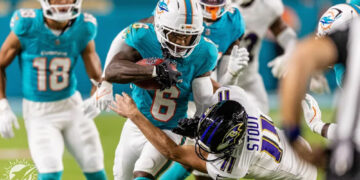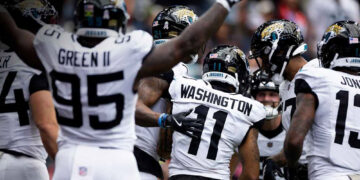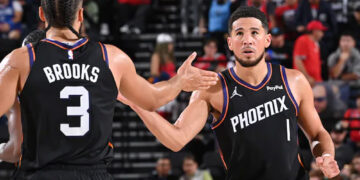The Denver Broncos vs New York Jets match on September 29, 2024, turned into one of the most talked-about games of the NFL season. Why? Because it was the lowest-scoring game of the year — a true defensive showdown.
Played in heavy rain at MetLife Stadium, the game tested both teams’ strength and patience. The Broncos managed to win 10-9, even though both offenses struggled badly. In this article, we’ll look closely at the Denver Broncos vs New York Jets match player stats, key plays, and the main moments that decided this tense, rainy battle.
Match Summary: Broncos Win in a Rainy Battle
This Week 4 game was a real grind. Over 82,000 fans sat through constant rain as both teams battled poor field conditions. The Broncos came in at 1-2, while the Jets were 2-1, hoping to keep their winning start alive.
In the end, Denver’s defense made the difference. The Jets had more possession and more yards, but the Broncos made the right plays at the right times. A single touchdown by Courtland Sutton was enough to win the game.
It wasn’t pretty, but sometimes football isn’t about beauty — it’s about grit, focus, and timing.
Full Denver Broncos vs New York Jets Match Player Stats
Here’s a quick look at how the two teams performed overall:
| Category | Broncos | Jets |
|---|---|---|
| Final Score | 10 | 9 |
| Total Yards | 123 | 229 |
| Passing Yards | 60 | 225 |
| Rushing Yards | 63 | 4 |
| First Downs | 10 | 18 |
| Third Down Efficiency | 0/7 (0%) | 1/7 (14.3%) |
| Red Zone Trips | 1/1 (100%) | 3/0 (0%) |
| Time of Possession | 28:16 | 31:44 |
The stats show a clear story — the Jets dominated on paper, but not on the scoreboard. Denver’s defense was simply too strong near the goal line. The Jets moved the ball well between the 20s but fell apart every time they got close to scoring a touchdown.
Meanwhile, the Broncos were more efficient. They had just one red zone trip, but they scored a touchdown from it — and that was all they needed to win.
Quarter-by-Quarter Breakdown
First Half
The first half was all Jets. They controlled the ball, drove down the field twice, and kicked two field goals. But they couldn’t find the end zone. Their quarterback Aaron Rodgers threw several tight passes, but Denver’s defense held firm.
The Broncos barely moved the ball early on. Their rookie QB Bo Nix struggled in the wet weather, completing only a handful of passes for short gains. Things got even worse when running back Tyler Badie left the game with a serious back injury after a big hit from Jets linebacker Quincy Williams.
By halftime, the Jets led 6-0, but the game still felt wide open.
Second Half
In the third quarter, everything changed. Bo Nix led a long, patient drive that ended with a beautiful 8-yard touchdown to Courtland Sutton. The Broncos took a 7-6 lead and never looked back.
The Jets tried to respond but couldn’t finish their drives. Denver’s defense grew stronger with every possession, forcing Rodgers to make quick throws and check-downs.
Bo Nix vs Aaron Rodgers: Quarterback Stats Compared
This matchup was a story of experience versus youth. Rodgers, one of the NFL’s legends, faced off against Bo Nix, a rookie still finding his rhythm.
| Quarterback | Comp-Att | Yards | TD-INT | Rating |
|---|---|---|---|---|
| Bo Nix (DEN) | 12-25 | 60 | 1-0 | 59.6 |
| Aaron Rodgers (NYJ) | 24-42 | 225 | 0-0 | 72.8 |
Nix had a rough start, especially in the first half where he finished with negative passing yards after several short screens and losses. But he bounced back after halftime with smarter throws and better decision-making. His touchdown to Sutton showed great poise — and for a young quarterback, that’s a big deal.
Rodgers, on the other hand, threw for 225 yards but failed to score a touchdown. He connected with eight different receivers but couldn’t crack Denver’s coverage when it mattered most.
Running Game Review: Big Efforts and Big Struggles
The ground game made all the difference in this wet-weather contest. Denver leaned heavily on Javonte Williams and Jaleel McLaughlin, who ran with power and control. Together, they helped keep the clock moving and gave Nix time to breathe.
| Player | Team | Attempts | Yards | Average |
|---|---|---|---|---|
| Javonte Williams | DEN | 16 | 77 | 4.8 |
| Jaleel McLaughlin | DEN | 9 | 46 | 5.1 |
| Breece Hall | NYJ | 10 | 4 | 0.4 |
The Jets’ rushing game completely collapsed. Breece Hall, usually a big-play threat, finished with just 4 yards on 10 carries. Denver’s defensive line dominated the trenches, shutting down every running lane before it opened.
It’s rare to see a team with only four rushing yards in a full NFL game — and that stat alone explains why the Jets lost.
Passing Game and Top Receivers
While neither team lit up the passing chart, there were a few standouts.
For the Jets, Mike Williams (67 yards) and Allen Lazard (58 yards) were Rodgers’ most trusted targets. They made some strong catches, especially in tight coverage. Garrett Wilson added 41 yards on five receptions, helping move the chains but never breaking free.
For Denver, the star was Courtland Sutton. He caught the only touchdown of the day — an 8-yard fade where he outjumped D.J. Reed in the corner of the end zone. It was a textbook play that showed Sutton’s strength and Nix’s growing trust in him.
Even with limited passing, that one moment turned out to be the difference between winning and losing.
Defensive Standouts in the Match
This game was all about defense. Both teams showed just how tough they can be when it matters most. The Broncos, especially, played with heart and power on every snap.
P.J. Locke was the hero on defense for Denver. He had 7 solo tackles, 1 sack, and the most important play of the game — a fourth-down sack on Aaron Rodgers that ended the Jets’ final big chance. That one play sealed the win for the Broncos.
Zach Allen and D.J. Jones also stood out. They broke through the Jets’ offensive line again and again, stopping the run and pressuring the quarterback. On the Jets’ side, C.J. Mosley led with 9 tackles, and Quinnen Williams caused problems all day for the Broncos’ offense with 3 QB hits.
Special Teams and Missed Chances
In games with low scores, special teams matter a lot — and this game was the perfect example. There were 15 punts in total, and every field goal really counted.
Greg Zuerlein made three field goals for the Jets but missed a 50-yarder late in the game that could’ve won it. That miss was heartbreaking for Jets fans. On the other side, Wil Lutz also missed one late, but luckily for Denver, it didn’t cost them the game.
Both punters — Riley Dixon for Denver and Thomas Morstead for the Jets — did a great job. They kept pushing the other team back, which made it harder to score.
Red Zone Struggles and Success
This is where the real difference showed up in the Denver Broncos vs New York Jets match player stats. Denver went into the red zone once — and scored a touchdown. That’s 100% efficiency.
The Jets reached the red zone three times and didn’t score a single touchdown. They had to settle for field goals or left empty-handed. That’s the main reason they lost.
You can move the ball all day, but if you can’t finish in the red zone, it’s hard to win games — especially when playing against a strong defense like Denver’s.
Big Moments That Changed the Game
Every football game has a few big moments that decide the result. This one had several.
-
Tyler Badie’s injury was a sad moment early in the game. He was hit hard and had to be taken off the field. It affected Denver’s game plan, but they stayed strong.
-
Allen Lazard’s penalty came at a bad time. After making a nice catch, he made a “gun gesture” while celebrating — and that drew a 15-yard penalty. It killed a promising Jets drive.
-
The biggest moment was P.J. Locke’s sack of Aaron Rodgers with 1:50 left. That play stopped the Jets from trying for a game-winning field goal.
Coaching Strategy and Game Plans
Credit goes to Sean Payton, Denver’s head coach. He made smart changes at halftime. In the first half, the Broncos had just 48 yards. In the second half, he called more running plays, and it worked.
By leaning on the run and simplifying the playbook for Bo Nix, Denver was able to control the game better and protect their lead.
Robert Saleh, the Jets’ coach, had a great defensive plan — but his offense couldn’t finish. Even though they had more plays and yards, they couldn’t score in the red zone. That was the big problem.
What This Match Means for Both Teams
For the Denver Broncos, this win was huge. They showed that even with low yardage, they could win with strong defense, smart plays, and heart. Their defense is clearly one of the best in the league right now.
For the New York Jets, this loss hurts. They played better in many areas, but couldn’t finish. The red zone struggles are becoming a serious issue, and they’ll need to fix that quickly if they want to compete this season.
Games like this remind us that football isn’t just about stats. It’s about moments, effort, and the will to win — and that’s exactly what the Broncos showed.
Bottom-Line
This game was a rare one — just 19 points total, with only one touchdown scored. The Denver Broncos vs New York Jets match player stats tell the full story: strong defense, smart coaching, and just enough offense made the difference.
Denver proved that you don’t need flashy numbers to win. Their defense stepped up when it mattered most, and Bo Nix made the one throw that counted. The Jets will walk away with regrets — too many missed chances and one painful penalty.
In a season full of high scores and fast plays, this game was a throwback — tough, slow, and decided by small details. And in the end, those small details gave Denver the win.
You may also read: Kansas City Chiefs vs Philadelphia Eagles Match Player Stats













